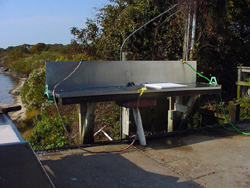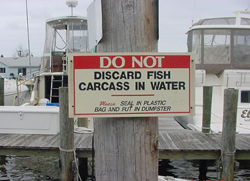New York Sea Grant's
Marina Pollution Prevention Web Site
Section 5: Facility
Management
- Fish Waste
Potential Environmental Impacts
Too much fish waste in a poorly circulated marina basin can lower
oxygen levels in the water. As the waste decomposes, it can lead
to foul odor and fish kills. Floating fish parts are also an unsightly
addition to marina waters.
Best Management
Practices
Prohibit disposal
of fish waste in the marina basin. Post signs displaying the rules.
Do not permit
fish cleaning on docks and floats.
 Install
a fish cleaning station at your marina. For examples of commercially
manufactured cleaning stations, click
here.
Install
a fish cleaning station at your marina. For examples of commercially
manufactured cleaning stations, click
here.
Clearly identify
the fish cleaning stations with signs that list the rules and
regulations for their use.
Direct rinse
water from fish cleaning areas to a sand filter or sanitary sewer.
It should be free of solids.
Use one of
the following disposal methods:
- Compost
fish waste where appropriate and use compost on landscaping.
See "Landscaping,"click
here, fact sheet for more information.
- Encourage
boaters to freeze fish parts and reuse them as bait or chum
on the next fishing trip. Use grinder to make chum out of fish
carcasses. Freeze and sell chum at marina store.
- If composting
or freezing is not an option, encourage boaters to double-bag
their fish parts and throw out in their regular trash.
 Encourage
boaters to clean fish offshore where the fish are caught and discard
of the fish in unrestricted waters, unless there are length limits
for the type of fish caught.
Encourage
boaters to clean fish offshore where the fish are caught and discard
of the fish in unrestricted waters, unless there are length limits
for the type of fish caught.
Regulatory
Issues
In New York,
state law prohibits the disposal of fish waste on the land or
into the water within 100 feet of the shoreline (Environmental
Conservation Law § 11-1321 Section 6, click
here).
Local harbor
management ordinances might prohibit the discharge of fish waste
within the jurisdiction of the harbor management plan. Check with
local harbor management committee or harbormaster, if applicable.
Disposal of
fish waste into an enclosed water body may be a violation of the
local health code. Check with your municipal or county health
authority.

